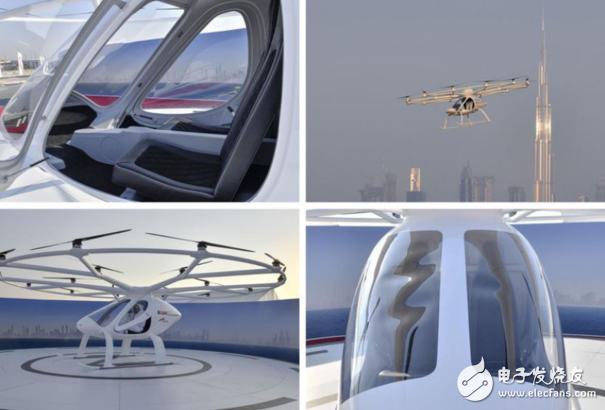The unmanned electric flight taxi developed by German drone manufacturer Volocopter is similar to a small two-seater helicopter cabin with a wide ring at the top and 18 propellers on it. Compared to conventional helicopters, this flying taxi is quieter, smaller and more environmentally friendly. It is 6.5 feet high and 22 feet wide. It has a charging time of 2 hours and a fast charging time of less than 40 minutes. It can accommodate two people. passenger. For safety reasons, this flight taxi is equipped with "excess" battery systems, propellers, electric motors, emergency parachutes, flight controls and a secure communications network. In this way, in the worst case, passengers can perform an emergency landing operation. The manufacturer pointed out that the first batch of licensed Volocopter flight taxis should be available in 2018 and the price is still unknown. In the test video, an all-white flying taxi that did not take up too much space took off in situ and flew over a height of about 200 meters. After flying for about 5 minutes, it landed gently. This public test marks another step in Dubai's transition to major transportation. According to the goals set by Dubai, by 2030, 25% of passengers travel by driverless cars. According to the “Traffic Index†released by the navigation company TomTom NV in February, Dubai is not the most congested city. In the world's worst traffic rankings, Dubai ranks 85th. Despite this, Dubai's rulers are determined to make Dubai a hub for transportation innovation. In the statement, Hamdan bin Mohammed bin Rashid Al Maktoum, the Crown Prince of Dubai, stated: “Encouraging innovation and adopting the latest technology will not only benefit Dubai’s development. It can also build a bridge to the future." Even in Dubai, unmanned flying cars still have a long way to go if they want to be “ordinary thingsâ€. The Dubai Road Traffic Authority said it needed to create a regulatory structure for “unmanned aerial taxisâ€, as well as safety standards, routes, take-off and landing points, and so on. If all goes well, the user will eventually be able to use the app to get around the flying taxi. Dubai hopes that these flying taxis will be integrated into other public transport systems in Dubai (such as subways, trams and marine transportation systems). The protagonist of this public test: the unmanned electric flight taxi developed by the German drone manufacturer Volocopter Volocopter is not the only manufacturer to develop guest drone taxis or vertical takeoff and landing aircraft. Aerospace's A3, a subsidiary of European Aerospace Defense Aerospace, is working on Vahana, a single-seat, self-driving, vertical take-off and landing manned aircraft. The drone's endurance is around 50 miles. Vahana is an electric vertical take-off and landing aircraft demonstrator with a tandem tilting wing layout and is scheduled to be tested at the end of the year. Airbus is now promoting Vahana, and the company is positioning Vahana not only for future air taxis, but also for express drones or emergency vehicles. It is understood that A3 has launched a future air traffic management project that allows different types of aircraft to share airspace and can be used for new missions. Uber is working with other companies to jointly carry the Uber version of the flying car. The company plans to conduct a flying car test in 2020. Larry Page, the founder of Google Inc., personally invested more than $100 million in Kitty Hawk, which is dedicated to the development of small all-electric aircraft capable of taking off and landing vertically. Kitty Hawk's electric airplane Flyer looks like Spider-Man's aerial motorcycle. The Flyer, capable of flying at a height of 15 feet above the water, is not unmanned and is classified as an ultralight aircraft by the US Federal Aviation Administration, so it does not require a flight driver's license to operate. It is expected that Flyer will be available for sale before the end of the year. It is also reported that Tesla has signed an agreement with Dubai to provide the latter taxi company with 200 Model S and Model X equipped with "unmanned functions". In the week of September 20th, Tesla officially delivered 50 of them, the first of which will be deployed at Dubai Airport. In addition to the 50 cars supplied this time, Tesla will deliver 75 cars in 2018 and 2019 respectively. In addition, the Dubai Taxi Company is coordinating with relevant parties to provide the required infrastructure (including 13 electric vehicle charging stations) to ensure the smooth operation of these unmanned taxis.
E-cig as a substitute of tobacco mainly reminds people of its potential benefits for health. Four ingredients contain in the e-liquid : propylene glycol, glycerin vegetable, nicotine and food grade essence. Nevertheless, smoke from cigarette contains carbon monoxide, tar, arsenic, ammonia, and many other cyanide and acetone.
Advantage
Wax Device Oem,Thc Wax Device Oem,Marijuana Wax Device Oem,High Cost Performance Wax Device Shenzhen MASON VAP Technology Co., Ltd. , https://www.e-cigarettefactory.com